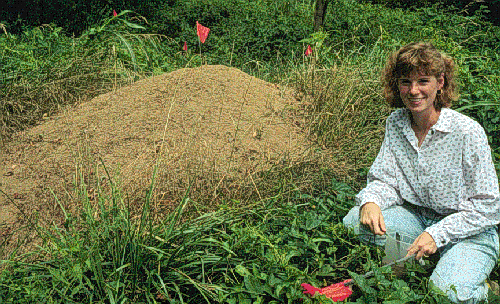Allegheny Mound Ants in Kentucky
ENTFACT-015: Allegheny Mound Ants in Kentucky | Download PDF
by Lee Townsend, Extension Entomologist
University of Kentucky College of Agriculture
The Allegheny mound ant is a native species that can be found along the Atlantic coast from Nova Scotia, Canada to Georgia. Known infestations in the Commonwealth range from eastern Kentucky to Franklin, Jefferson, and Shelby counties in the central part of the state. The most conspicuous feature of this species is the large mound that is built. These are accumulations of soil brought to the surface as the ants excavate burrows and chambers that extend deep into the ground. A 5 month-old mound can be about 2 feet wide and 8 inches tall, within two years, mounds can be up to 3 feet tall. In infested areas, mounds tend to be built in pastures that are grazed regularly and mowed infrequently. They also can become pests in Christmas tree plantings, nurseries, and turf.
 Allegheny Ant Mound
Allegheny Ant Mound
Mound-building is not the only negative aspect of these ants. They inject formic acid into plants and vegetation near the mound. Small trees and shrubs within 40 to 50 feet of large mounds can be killed. Studies in West Virginia showed that 2 to 5 year-old trees near large mounds are especially susceptible to damage but trees up to 8 feet tall could be killed. If the ants become established in lawns, they can kill the grass around the mound and their foraging activity can may work or play in the area very unpleasant. They will bite if the colony is disturbed.
Numbers of mound ants can increase rapidly. The life cycle from egg to adult ranges from 2 to 3-1/3 months, depending primarily on temperature. Eggs are present during the spring and early summer and the white legless larvae are cared for by workers in galleries in the soil. These tunnels may go down 3 feet into the soil and extend up to 4 feet out from the mound. A process of "budding" results in formation of new mounds as the ants spread out from the original mound. Most new colonies develop in late May and early June.
General population sizes associated with mound diameter are:
- 6" to 18"- 500 to 3,000;
- 18" to 36" - 1,000 to 6,000; and
- 36" to 60" - 3,000 to 10,000.
The ant population at a Maryland study site was estimated at 1,200,000 per acre- or about 27 per square foot.
Mound ants feed on most any type of small insect or arthropod that they can find as they forage or hunt over the ground. In addition to this protein source, the ants collect the carbohydrate-rich "honey dew" secretions from sapsucking insects such as aphids and leafhoppers. They rarely enter homes or buildings in search of food.
CONTROL
The ant can be controlled by direct application of a residual insecticide to the mound. A variety of products are labeled for ant control in lawns. Search the area to locate mounds. For best results, the top of the mound should be scraped away with a shovel to expose the large tunnels below it. It is safe to assume that the ants will not ignore this intrusion, so be prepared by having on long pants which have been tucked into socks or boot tops. A brush will be useful to remove ants that crawl on to you during the operation. After opening a mound, pour in about one gallon of the diluted material per foot of mound diameter so that it soaks into the soil. Repeat the process at each mound.
Because of the budding activity from established colonies, there may be small mounds that are easily overlooked. Inspect every year to locate and treat these sites.
Modified in part from Circular 159, by J. E. Weaver and B. D. Smith, Agricultural and Forestry Experiment Station, West Virginia University, 1993.
Revised:12/95
CAUTION! Pesticide recommendations in this publication are registered for use in Kentucky, USA ONLY! The use of some products may not be legal in your state or country. Please check with your local county agent or regulatory official before using any pesticide mentioned in this publication.
Of course, ALWAYS READ AND FOLLOW LABEL DIRECTIONS FOR SAFE USE OF ANY PESTICIDE!
Images: University of Kentucky Entomology
